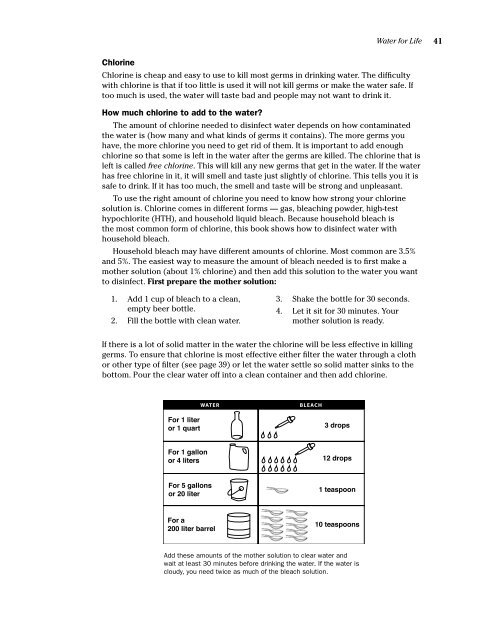Community water security - UN-Water
Community water security - UN-Water
Community water security - UN-Water
Create successful ePaper yourself
Turn your PDF publications into a flip-book with our unique Google optimized e-Paper software.
<strong>Water</strong> for Life<br />
41<br />
Chlorine<br />
Chlorine is cheap and easy to use to kill most germs in drinking <strong>water</strong>. The difficulty<br />
with chlorine is that if too little is used it will not kill germs or make the <strong>water</strong> safe. If<br />
too much is used, the <strong>water</strong> will taste bad and people may not want to drink it.<br />
How much chlorine to add to the <strong>water</strong>?<br />
The amount of chlorine needed to disinfect <strong>water</strong> depends on how contaminated<br />
the <strong>water</strong> is (how many and what kinds of germs it contains). The more germs you<br />
have, the more chlorine you need to get rid of them. It is important to add enough<br />
chlorine so that some is left in the <strong>water</strong> after the germs are killed. The chlorine that is<br />
left is called free chlorine. This will kill any new germs that get in the <strong>water</strong>. If the <strong>water</strong><br />
has free chlorine in it, it will smell and taste just slightly of chlorine. This tells you it is<br />
safe to drink. If it has too much, the smell and taste will be strong and unpleasant.<br />
To use the right amount of chlorine you need to know how strong your chlorine<br />
solution is. Chlorine comes in different forms — gas, bleaching powder, high-test<br />
hypochlorite (HTH), and household liquid bleach. Because household bleach is<br />
the most common form of chlorine, this book shows how to disinfect <strong>water</strong> with<br />
household bleach.<br />
Household bleach may have different amounts of chlorine. Most common are 3.5%<br />
and 5%. The easiest way to measure the amount of bleach needed is to first make a<br />
mother solution (about 1% chlorine) and then add this solution to the <strong>water</strong> you want<br />
to disinfect. First prepare the mother solution:<br />
1.<br />
2.<br />
Add 1 cup of bleach to a clean,<br />
empty beer bottle.<br />
Fill the bottle with clean <strong>water</strong>.<br />
3.<br />
4.<br />
Shake the bottle for 30 seconds.<br />
Let it sit for 30 minutes. Your<br />
mother solution is ready.<br />
If there is a lot of solid matter in the <strong>water</strong> the chlorine will be less effective in killing<br />
germs. To ensure that chlorine is most effective either filter the <strong>water</strong> through a cloth<br />
or other type of filter (see page 39) or let the <strong>water</strong> settle so solid matter sinks to the<br />
bottom. Pour the clear <strong>water</strong> off into a clean container and then add chlorine.<br />
WATER<br />
BLEACH<br />
For 1 liter<br />
or 1 quart<br />
3 drops<br />
For 1 gallon<br />
or 4 liters<br />
12 drops<br />
For 5 gallons<br />
or 20 liter<br />
1 teaspoon<br />
For a<br />
200 liter barrel<br />
10 teaspoons<br />
Add these amounts of the mother solution to clear <strong>water</strong> and<br />
wait at least 30 minutes before drinking the <strong>water</strong>. If the <strong>water</strong> is<br />
cloudy, you need twice as much of the bleach solution.
















